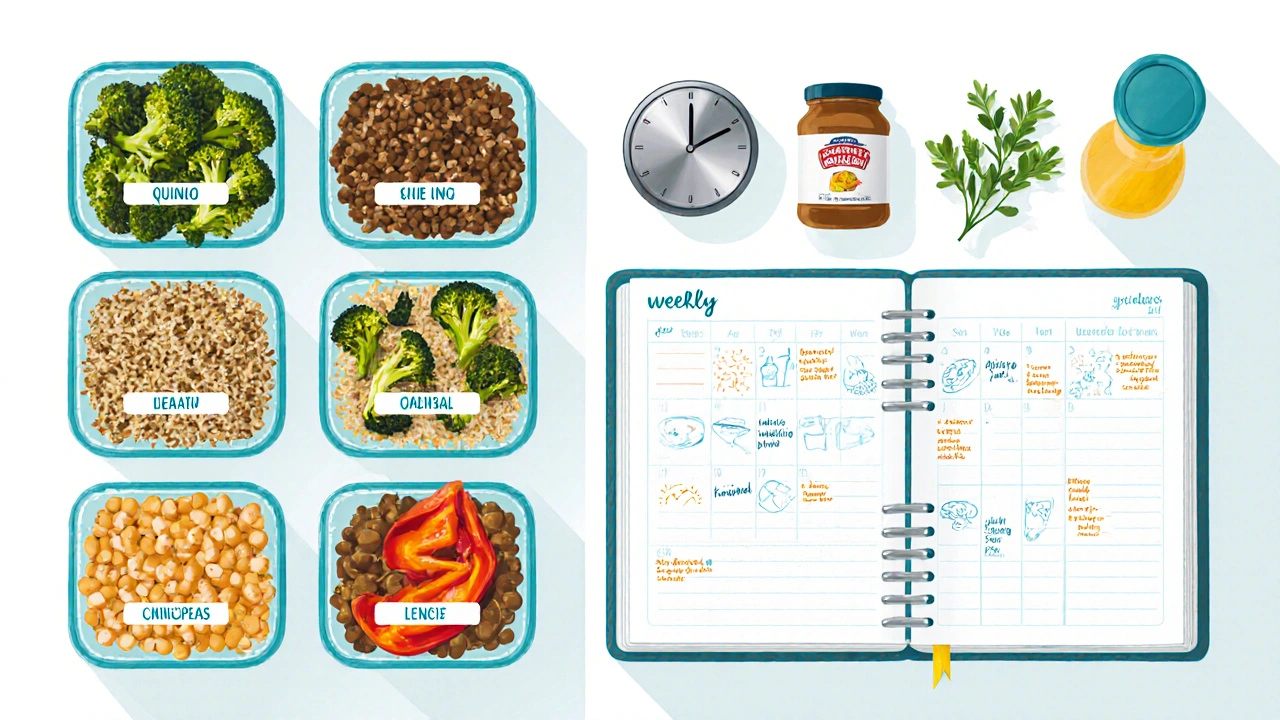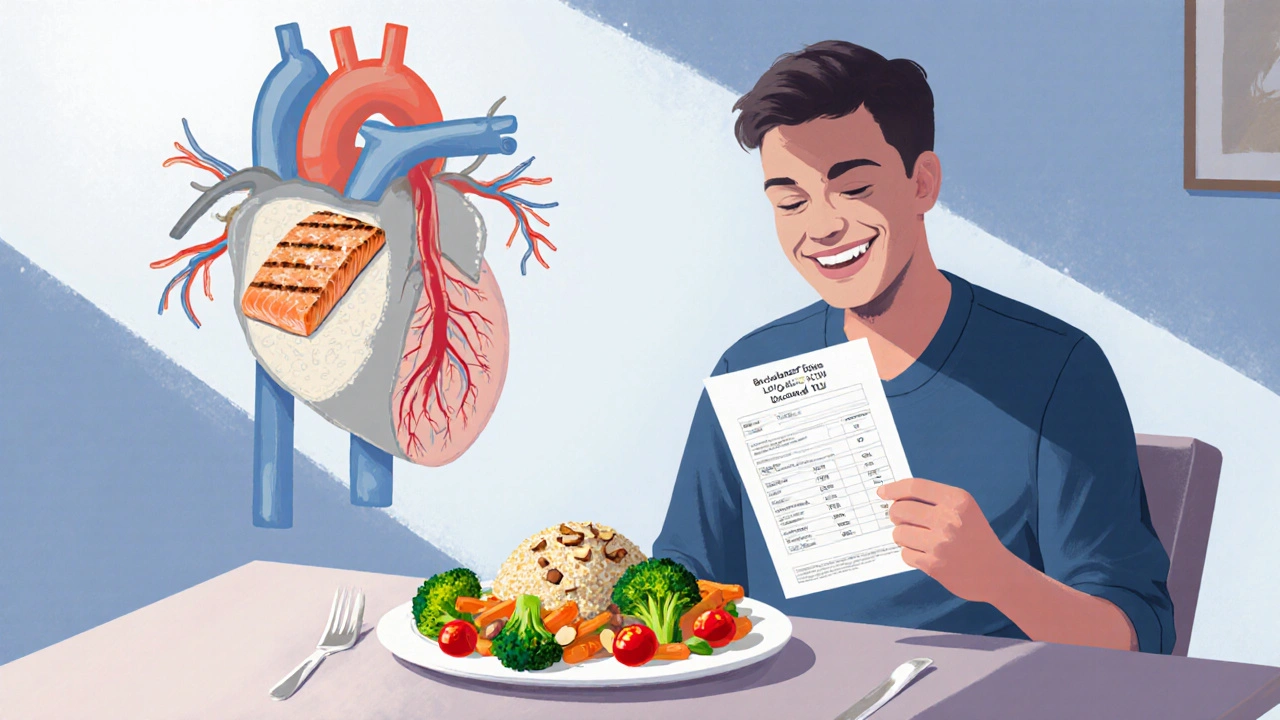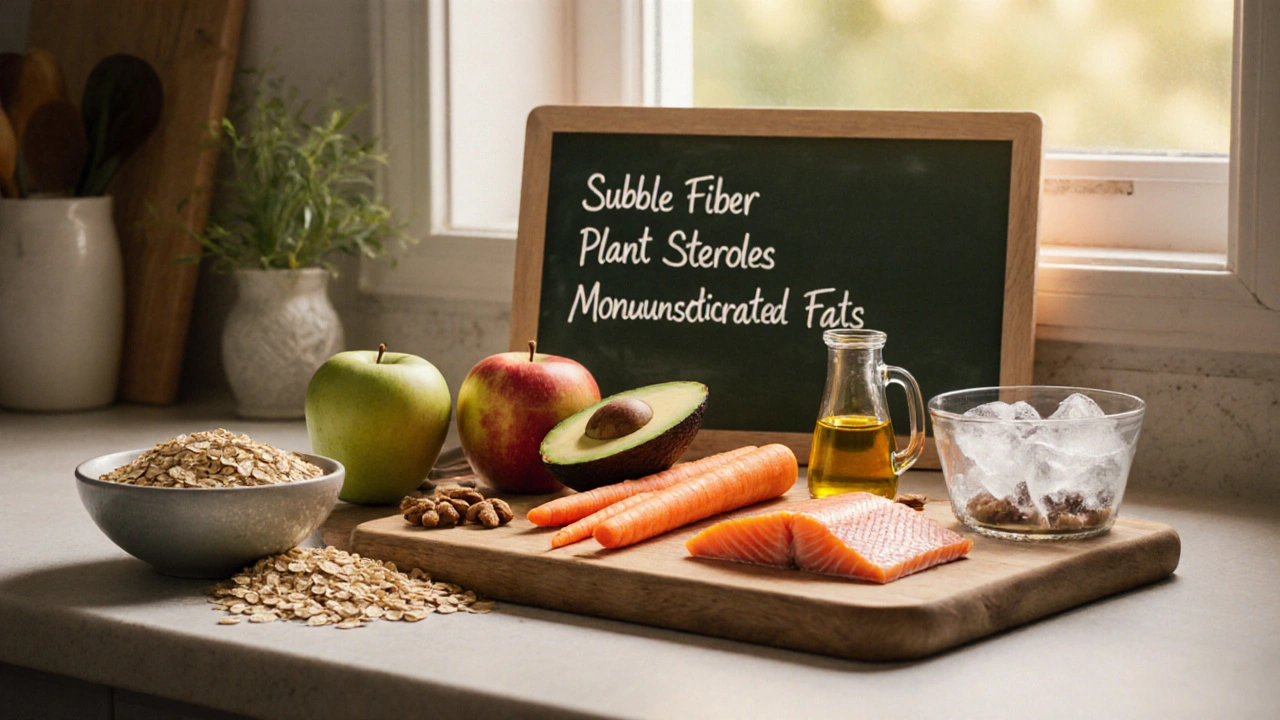Heart-Healthy Meal Plan Calculator
Your Cholesterol-Lowering Meal Plan
Step 1: Enter Your Information
High blood cholesterol can feel like a silent threat, but the right food choices can turn the tide. Below you’ll find a step‑by‑step guide to building a heart-healthy meal plan that tackles LDL, boosts HDL, and keeps your arteries happy.
Key Takeaways
- Focus on soluble fiber, plant sterols, and healthy fats to lower LDL.
- Swap saturated fats for monounsaturated and polyunsaturated oils.
- Use the Mediterranean or DASH diet as a template for variety and balance.
- Plan meals ahead, batch‑cook, and keep a pantry of cholesterol‑friendly staples.
- Track progress with simple blood‑test checks every 3‑6 months.
Heart‑healthy meal plan is a structured set of meals designed to reduce cholesterol levels while providing balanced nutrition. By prioritizing foods that lower LDL cholesterol and raise HDL cholesterol, the plan helps prevent artery plaque buildup.
Understanding Cholesterol: The Good, the Bad, and What You Can Change
Cholesterol travels in the blood on lipoproteins. LDL cholesterol (low‑density lipoprotein) is the “bad” kind that can stick to artery walls, while HDL cholesterol (high‑density lipoprotein) helps carry cholesterol away for disposal. Most guidelines target an LDL level below 100mg/dL for people at risk, and aim for HDL above 40mg/dL (men) or 50mg/dL (women).
Diet influences these numbers mainly through two mechanisms:
- Saturated fat raises LDL. Typical culprits are fatty cuts of meat, butter, cheese, and many processed snacks.
- Soluble fiber and plant sterols trap cholesterol in the gut, reducing the amount that enters the bloodstream.
Knowing which foods affect each pathway lets you craft a plan that attacks the problem from both sides.
Core Food Groups for a Cholesterol‑Lowering Plate
Here are the six groups that should dominate every day’s menu.
- Soluble fiber sources - oats, barley, beans, lentils, apples, and carrots. Aim for at least 5‑10g per day.
- Plant sterols - fortified spreads, nuts, seeds, and legumes. A daily dose of 2g can cut LDL by up to 10%.
- Monounsaturated fats - olive oil, avocado, and nuts. They improve HDL and keep LDL low.
- Polyunsaturated fats, especially omega‑3 fatty acids - salmon, sardines, flaxseeds, walnuts. Omega‑3s lower triglycerides and modestly raise HDL.
- Low‑sodium vegetables - leafy greens, broccoli, peppers, and tomatoes. They provide antioxidants and keep blood pressure in check.
- Whole grains - quinoa, brown rice, whole‑wheat pasta. They add fiber and prevent spikes in blood sugar.

Step‑by‑Step: Building Your Weekly Meal Plan
Follow these five steps to design a plan that sticks.
- Calculate your calorie budget. Use an online calculator (multiply body weight by 13‑15kcal for modest weight loss) and subtract 500kcal if you need to lose weight, which further improves cholesterol.
- Choose a diet framework. The Mediterranean diet or the DASH diet provide ready‑made templates that meet heart‑healthy guidelines.
- Map food groups to meals. For each of the 7 days, allocate:
- Breakfast - a soluble‑fiber base (oats or whole‑grain toast) + fruit + a spoonful of nuts.
- Lunch - leafy salad + lean protein (chickpeas, fish) + a drizzle of olive oil.
- Dinner - half plate veggies, quarter lean protein, quarter whole grain.
- Snacks - raw veggies, a piece of fruit, or a small portion of fortified spread.
- Batch‑cook staples. Cook a large pot of beans, quinoa, and roasted veg on Sunday. Store in portioned containers for quick assembly.
- Track and adjust. Keep a simple log of meals and weekly LDL/HDL results. If LDL isn’t dropping, swap a high‑saturated item for another fiber‑rich alternative.
Sample 7‑Day Menu (All Under 2g Saturated Fat per Day)
Feel free to mix and match, but this template shows the balance you need.
- Day1 - Breakfast: Oatmeal topped with sliced apple and 1tbsp ground flaxseed. Lunch: Mixed‑green salad with chickpeas, cherry tomatoes, cucumber, olive‑oil‑lemon dressing. Dinner: Grilled salmon, quinoa, steamed broccoli.
- Day2 - Breakfast: Whole‑grain toast with avocado and a sprinkle of sesame seeds. Lunch: Lentil soup + side of whole‑grain crackers. Dinner: Stir‑fried tofu, brown rice, bell peppers, snap peas.
- Day3 - Breakfast: Greek‑style low‑fat yogurt (plain) mixed with berries and 1tbsp chia seeds. Lunch: Turkey wrap in whole‑wheat tortilla with lettuce, mustard, and sliced orange. Dinner: Baked cod, sweet‑potato wedges, roasted Brussels sprouts.
- Day4 - Breakfast: Smoothie with oat milk, banana, spinach, and a scoop of plant‑sterol‑fortified spread. Lunch: Quinoa salad with black beans, corn, cilantro, lime vinaigrette. Dinner: Chicken breast (skinless) baked with herbs, barley pilaf, green beans.
- Day5 - Breakfast: Muesli with low‑fat milk, raisins, and sliced almonds. Lunch: Tomato‑basil soup + side salad with walnuts. Dinner: Shrimp sautéed in olive oil, whole‑grain pasta, mixed veg.
- Day6 - Breakfast: Berry‑cottage cheese bowl with a drizzle of honey. Lunch: Falafel balls, tabbouleh, tahini sauce. Dinner: Beef sirloin (lean) stir‑fry with bok choy, brown rice.
- Day7 - Breakfast: Buckwheat pancakes topped with fresh strawberries. Lunch: Spinach‑feta (low‑fat) omelet, whole‑grain toast. Dinner: Veggie‑laden chili with kidney beans, served over quinoa.
Comparing Two Proven Diets
| Aspect | Mediterranean Diet | DASH Diet |
|---|---|---|
| Primary Fat Source | Olive oil, nuts, avocado (monounsaturated) | Low‑fat dairy, canola oil (mixed mono & poly) |
| Daily Soluble Fiber Goal | 5‑10g (oats, legumes, fruit) | 5‑10g (whole grains, veggies) |
| Plant Sterol Inclusion | Optional, fortified spreads | Recommended, especially in spreads |
| Sodium Target | ≤2,300mg (moderate) | ≤1,500mg (low) |
| Evidence on LDL Reduction | ~10‑15% drop after 6weeks | ~8‑12% drop after 8weeks |
| Ease of Adoption (UK perspective) | High - aligns with local Mediterranean restaurants | Medium - requires more low‑salt product hunting |
Both plans meet the core cholesterol‑lowering criteria. Pick the one that fits your lifestyle: Mediterranean for flavorful olive‑oil dishes, DASH for stricter sodium control.

Practical Tips to Stick With Your Plan
- Prep in batches. Cook beans, grains, and roasted veg on weekends. Store in airtight containers.
- Smart grocery trips. Stick to the perimeter of the store where fresh produce, fish, and dairy live. Avoid the snack aisles.
- Use spices, not salt. Lemon zest, garlic, smoked paprika, and fresh herbs add flavor without raising blood pressure.
- Read labels for hidden saturated fat. Look for “partially hydrogenated” or “cream” in ingredient lists.
- Keep a cholesterol‑friendly pantry. Stock oats, canned beans (no‑salt), whole‑grain pasta, nuts, and fortified spreads.
Common Pitfalls & How to Fix Them
Pitfall 1 - Over‑relying on “low‑fat” labels. Many low‑fat products add sugar to compensate, which can raise triglycerides. Choose whole‑food options instead.
Pitfall 2 - Skipping fiber. If you drop breakfast oats, you lose a major source of soluble fiber. Swap with a high‑fiber alternative like barley or psyllium husk.
Pitfall 3 - Eating out too often. Restaurant dishes often hide butter and cream sauces. Request “grilled, not fried” and ask for sauces on the side.
Mini FAQ
How quickly can I see a drop in LDL?
Most people notice a 5‑10% reduction within 4‑6 weeks when they stick to a heart‑healthy meal plan that includes at least 5g of soluble fiber daily.
Do I need to eliminate all cholesterol‑rich foods?
No. Dietary cholesterol has a modest effect on blood levels for most people. Focus on cutting saturated fat and adding fiber; a couple of eggs a week are fine for most adults.
Can plant sterol spreads replace medication?
They can lower LDL by about 10% but shouldn’t replace prescribed statins without a doctor’s approval. Think of them as a supplement, not a cure.
Is the Mediterranean diet high in calories?
It can be, if you over‑do the olive oil and nuts. Keep portions in check-about 2tbsp of oil and a small handful of nuts per day works well.
How often should I get my cholesterol checked?
If you’re making lifestyle changes, every 3‑6 months is a good rule. After levels stabilize, an annual test is enough for most adults.
Take these steps, keep experimenting with flavors, and treat your plate as a daily prescription. With commitment, you’ll watch your numbers shift, feel more energetic, and protect your heart for years to come.
